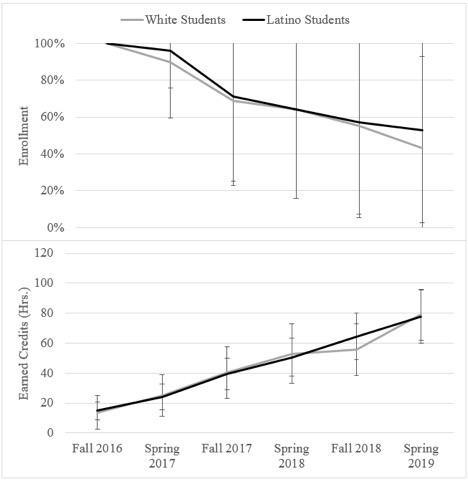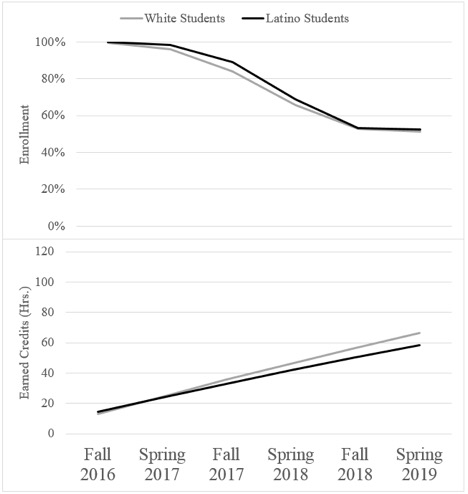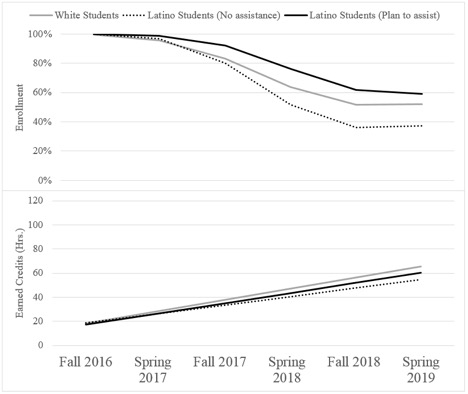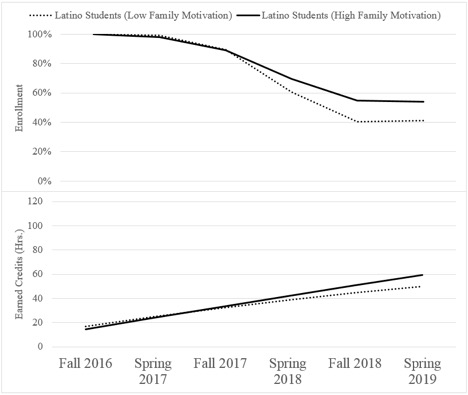November 2019
Dr. Kerrie DeVries, Bloomsburg University of Pennsylvania
Dr. Jonathan B. Santo, University of Nebraska at Omaha
Dr. Juan F. Casas, University of Nebraska at Omaha


Latinos are among the largest and fastest growing minority group in the United States. However, multiple sources point to a disturbing trend in that they also have among the lowest college completion rates. According to The White House Initiative on Educational Excellence for Hispanics (2014), whereas Latino high school graduation rates have improved in the last decade, only 15% of Latino adults hold a bachelor’s degree.
To that point, there are a number of challenges facing Latino students in their pursuit of an undergraduate education. One factor that undermines Latino student’s progress in University is the misperception that they are less well prepared for success in college relative to their classmates. Another is time spent on family responsibilities, particularly for women, which translates to less time on campus and therefore less time in class, doing homework or interacting with faculty which decreases their likelihood of eventually graduating. With these challenges facing them, it is crucial to identify the strengths that Latino students have that can help them achieve their goal of completing their degrees. This more holistic view of Latinos in higher education will be increasingly important as the numbers of Latinos in college continues to rise both locally and nationally.
Using data from UNO to address these challenges
We have data that might answer some of these questions. One of us (Kerrie) did her dissertation with data from a longitudinal study following 582 University of Nebraska at Omaha (UNO) Freshman from diverse backgrounds over six semesters. At the start of their first semester here at UNO, the participants filled out a number of measures that in other studies have been linked with student success. For example, Kerrie’s dissertation described how students’ intentions to persist in college played a strong role in predicting actual persistence in enrollment over time. In the end, our hope is that the results from Kerrie’s study may aid institutions as they consider different strategies for institutional persistence for diverse students. In this case, the data can be used to identify factors that predict long term success for Latino students at UNO and other institutions of higher education. Below, we’ve plotted the average percentage of those students consistently enrolled in courses and the number of earned credits over time.

Presented above are two important patterns of change over time. We have plotted the enrollment rates and earned credits hours over each of the six semesters among the White students in the sample (N = 327) and those who identified as Latino (N = 95). As can be seen, there are not large differences between these two groups. Notice the large error bars around all of the scores though. This tells us that there are a lot of differences between people in these patterns of change over time. Our goal was to account for these differences using a combination of variables to ultimately explain what predicts why some students accrue credits more slowly than others and beyond that, why some students may stop enrolling at UNO entirely. We used this data to provide hints as to what factors may serve to help all students in general and Latino students in particular succeed over time.
Differences between White and Latino UNO students
The jumping off point for our analyses was simply getting a better understanding of the differences between Latino UNO students and their White classmates. By and large, the two groups of students had more similarities than differences. For example, they gave comparable responses to their reasons for going to college. They also felt similarly close to their families and felt that their families supported their efforts to pursue a college degree. A few differences did emerge though. Not surprisingly, Latino students felt they had a stronger ethnic identity. More pertinent however, as has been shown in other studies, the Latino students in our sample were more likely to report expecting to have to help their families. Specifically, whereas 50% of White students told us that they intend to help family members with household duties such as childcare, language interpretation and transportation while in college, this number was as high as 83% among Latino students in our sample.

There were other differences as well. Although Latino and White students were enrolling in courses in comparable numbers from semester to semester, there was a creeping trend in our data (displayed in the figure above). Namely, over each semester, Latino students were accumulating on average 1.5 credits less than their White classmates. This may not sound like an alarming difference but at the end of three years of the study, Latino students had earned almost 8 fewer credits than White students. This amounts to the equivalent of being almost three classes behind, a difference that likely continues to grow over time. What this finding tells us is that Latino students are at risk of graduating later and possibly accumulating more debt than their White counterparts. More concerning is that previous research has shown that taking longer to complete a degree makes it more and more difficult for students to persist over time, ultimately endangering their chances of graduating.
UNO Latino students playing to their strengths
The encouraging detail to all this is that we found one factor that mitigated this effect for Latino students. Remember earlier when we mentioned differences between students in how they changed over time? There is one measure in our data that predicts better outcomes, namely plans to help family members with household duties, childcare, language interpretation and transportation while in college but only among the Latino students. The figures below illustrate what we found. Specifically, Latino students who reported planning to help their families had higher enrollment rates over time and more earned credits as well.

Why might this be the case? In all honesty, we don’t know. However, we do have a few clues in the data. One hint is that the students in our sample who expected to help their families out while in college also reported feeling closer to their families, and that’s not all. Those students who said they felt closer to their families were also more likely to tell us that their parents and relatives wanted them to graduate from college too. It turns out that feeling that your family really wants you to succeed in college predicts more consistent enrollment and more credits earned over time (see below). This might be what the Latino students have to their advantage.

Where to go from here
These findings hint that Latino students attending UNO bring with them strengths that can help temper some of the challenges they may face in their pursuit of a university degree. These findings suggest that for the majority of students, having parents and relatives who support their goal of graduating from college was linked with better outcomes towards that goal, namely higher enrollment and more earned credit hours. For Latino students specifically, planning on helping their families buffered the differences we observed between them and their White classmates.
This is important and perhaps not too surprising given that many Latino students are also first generation students. Moreover, this data provides some initial findings that suggest that many of the issues that are commonly believed to pull students away from persisting in college may be protective to some degree if they are paired with close and supportive family relationships. We believe there are other strengths that these students possess that will benefit them beyond their time here at UNO. Our role as educators and scientists are not only to identify the factors that put them at risk of achieving academic success but most importantly to zero in on the qualities that can help them achieve their goals over time.
Acknowledgments: The authors would like to thank the participating students, the instructors who allowed us into their classes for recruitment, UNO administration and the Office of Institutional Effectiveness for providing us with enrollment and earned credit hour data. Finally, we would like to thank Dr. Doña-Reveco for providing feedback on earlier drafts of this blog post.